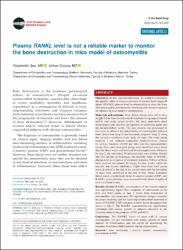Plasma rankl level is not a reliable marker to monitor the bone destruction in mice model of osteomyelitis

View/
Access
info:eu-repo/semantics/openAccesshttp://creativecommons.org/licenses/by-nc/3.0/us/Date
2022Metadata
Show full item recordAbstract
Objectives: In this experimental study, we aimed to investigate
the specific value of receptor activator of nuclear factor kappa-Β
ligand (RANKL) plasma level in osteomyelitis to show the bone
destruction and to determine its correlation with classical markers
of infection in mice model of osteomyelitis.
Materials and methods: Sixty Balb/c female mice (30 to 40 g
weight, 3.5 to 4 month-old) were divided into two groups: Controls
(n=15) and study group (n=45). All mice underwent tibial
decortication and received an injection of sclerosing agent into
the intramedullary cavity. The next process was proceeded in
two steps to observe the detectability of osteomyelitis-induced
bone destruction (step 1) and treatment response (step 2) using
the variables examined in our study. In step 1, the study group
received 1 mL solution containing Staphylococcus aureus
(S. aureus) bacteria (2¥108 per mL) into the intramedullary
cavity. Five mice from each group were sacrificed every seven
days for three weeks and tibia and blood samples were obtained.
In step 2, the remaining 30 infected mice were further divided
into two groups to investigate the possible value of RANKL
plasma level as a marker of treatment response. Fifteen of these
mice received teicoplanin 20 mg/kg for four weeks, while the
rest did not receive antibiotics. Eight mice from each group
were sacrificed at the end of the second week and the remaining
14 mice were sacrificed at the end of four weeks. Complete
blood count, procalcitonin level, C-reactive protein (CRP), and
RANKL concentrations were measured from blood samples of
each sacrificed mouse.
Results: Median RANKL concentration of the control subjects
was significantly higher than recipients of intervention at the
first and third weeks in step 1 where bone destruction of
osteomyelitis was examined. No significant changes occurred
in groups receiving and not receiving antimicrobial treatment in
terms of RANKL, CRP, and procalcitonin levels throughout four
weeks in step 2. The RANKL concentration was significantly
correlated with colony growth in subjects allocated to the
S. aureus inoculation group (r=-0.547, p=0.035).
Conclusion: The RANKL levels in mice with S. aureus
osteomyelitis are not correlated with colony growth or other
markers of inflammation and not useful for monitoring the
response to antimicrobial treatment during osteomyelitis.
Source
Joint Diseases and Related SurgeryVolume
33Issue
1Collections
The following license files are associated with this item:


















